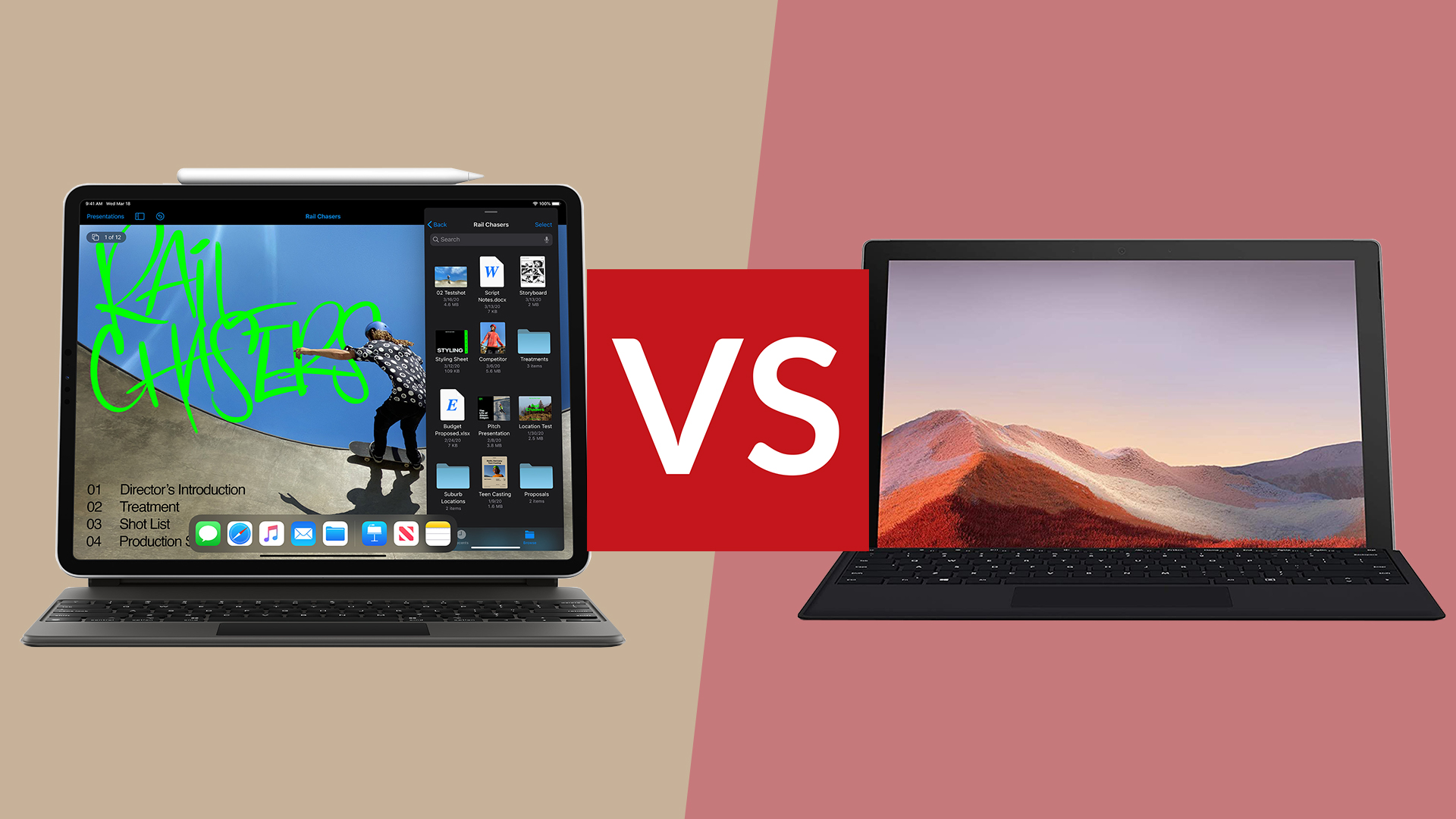

The iPad Pro vs Surface Pro 7 story is a tale of two of the best tablets, both of which are aimed at power users. Apple’s iPad Pro takes a super-sleek design and packs in a top-tier display and tons power, while the Surface Pro 7 is faster and more flexible than ever before, still bringing a PC's versatility to a tablet size.
Their prices are similar, but the way they do things differs – not least because they run very different operating systems and apps. So which one is the best Pro tablet for power users? Let’s explore the key differences.
Note: this article explores the 2020 iPad Pro series, but a newer iPad Pro 2021 series has since launched; there's also the Surface Pro 8 on the market now, so if you're looking for even newer kit then be sure to check out those individual reviews during your research.
iPad Pro vs Surface Pro 7: Design and display
The iPad Pro has the familiar big-screen look of tablets, but using Face ID for security means it has much slim bezels for a really sleek overall look, especially in the 12.9-inch version, where the screen-to-body ratio is higher.
The 11-inch iPad Pro has a 'Retina' LCD display with 2388x1668 pixels at 264ppi. The 12.9 inch model delivers 2732x2048 pixels, also at a density of 264ppi. Both screens are Wide Colour Displays with P3 colour, ProMotion for a 120Hz refresh rate, and True Tone for adapting the colours to match the environment, making them easier on the eyes.
There’s only one display option for the Surface Pro 7. It’s a 12.3-inch LCD display delivering 2736x1824 resolution at 267ppi. As with previous Surface Pros there isn’t much to visually distinguish it from any other tablet bar its integrated kickstand; there’s only so much you can do to differentiate designs that are made primarily of screens. It's chunkier than the iPad Pro, and just a little less slick looking, but we're being picky really.
The Surface Pro 7 weighs 772g without its optional keyboard. The 11-inch iPad Pro is 471g and the 12.9-inch is 641g. You can get the iPad Pros with Wi-Fi-only or with 4G included.
Sign up to the T3 newsletter for smarter living straight to your inbox
Get all the latest news, reviews, deals and buying guides on gorgeous tech, home and active products from the T3 experts
iPad Pro vs Surface Pro 7: Processor and storage
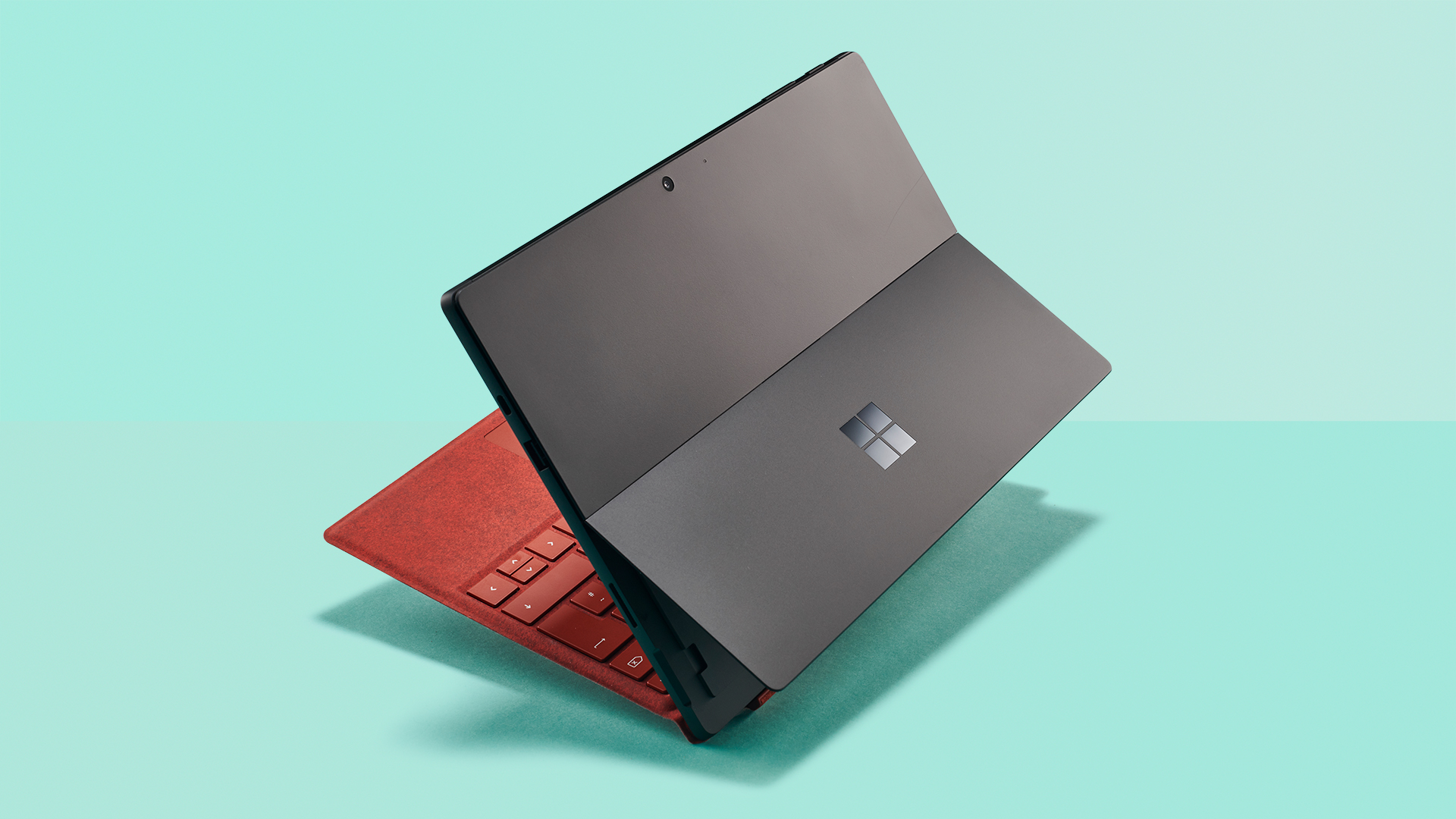
The Surface Pro 7, with Type Cover.
The Surface Pro 7 is faster and offers better graphics than before, and you can specify it with 4GB, 8GB, or 16GB of RAM, plus an SSD with 128GB, 256GB, 512GB or 1TB.
There are three processor options for the Surface Pro 7. There’s a dual-core, 10th generation Core i3-1005G1; a quad-core, 10th generation Core i5-1035G4; and a quad-core 10th generation Core i7-1065G7.
That latter option benchmarks almost identically to the octa-core A12Z processor in the iPad Pro. Like the Surface, the iPad Pro comes with storage options from 128GB to 1TB. You can't configure the RAM – you get 6GB in all models. Because iPadOS works quite differently to Windows when it comes to memory management, its RAM needs are generally lower.
The graphics processor in the iPad Pro is integrated into the A12Z – it's an Apple design with eight cores. The GPU you get on the Surface Pro 7 depends on the processor: the Core i3 version gets Intel UHD Graphics, and the i5 and i7 get Intel Iris Plus Graphics.
iPad Pro vs Surface Pro 7: cameras and audio
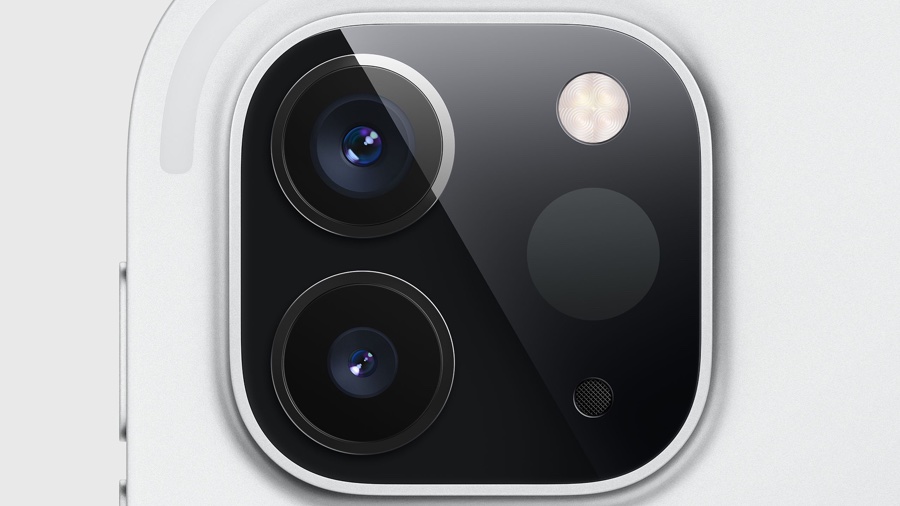
The iPad Pro 2020's camera.
The Surface Pro 7 has identical cameras to the more affordable Surface Go 2. Its 5.0MP front facing camera is capable of 1080p Skype video and Windows Hello; the rear camera is 8MP and again, 1080p. There’ are dual far-field microphones and twin 1.6W speakers with Dolby Audio.
Apple’s camera system is higher resolution and more flexible. On the rear, there are 12MP wide and 10MP ultra wide cameras capable of 4K video recording at up to 60fps, paired with a LiDAR sensor for depth detection in 3D. The 7MP TrueDepth camera on the front has impressive portrait mode capabilities. The five-microphone array is great for picking up voices, and there's a clever four-speaker arrangement – there's a driver setup in each corner, so whichever way you hold it, it can create a wide stereo soundstage.
iPad Pro vs Surface Pro 7: Operating system and apps
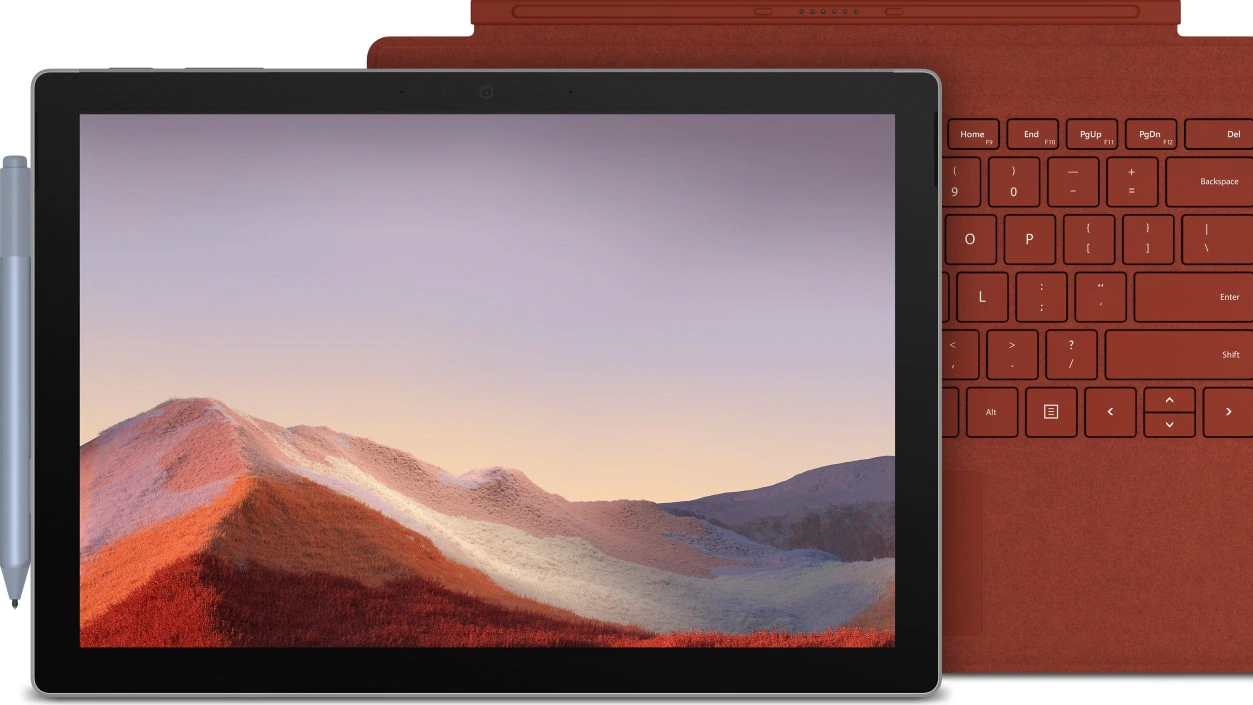
The Surface Pro is a full-fat Windows 10 device and ships with Windows 10 Home installed. That means you have access to the entire world of Windows apps, not just the Microsoft Store ones in the Windows 10 S mode of the Surface Go 2.
As ever, the iPad runs Apple’s own iPadOS, which is basically a version of the iPhone's operating system with extra power for mulitasking and connecting to accessories, including external storage.
The Surface Pro is a Windows PC but the iPad is not a Mac. And that’s an important consideration for the kind of people who may be considering a pro-level tablet: professional illustrators, artists, music producers and so on.
For example, while Photoshop and Illustrator on iPad are impressive they do not have full feature parity with the desktop apps; on the Surface Pro that isn’t an issue because it runs the desktop versions. There’s no iPad version of Apple’s Logic Pro X or Final Cut Pro X, and while music apps can use Ableton Link there’s no native Ableton Live.
However, the apps on iPad are all optimised for the size of the screen and that it's a touchscreen device – the Surface Pro 7 might be able to run any software you like, but it won't necessarily be touch friendly if it was originally designed for the precision of a mouse. Of course, you can use a mouse with the Surface Pro 7 instead to help things out. You can actually use a mouse or trackpad with the iPad Pro too, but the apps you run remain the same.
iPad Pro vs Surface Pro 7: Connectors, stylus and keyboard
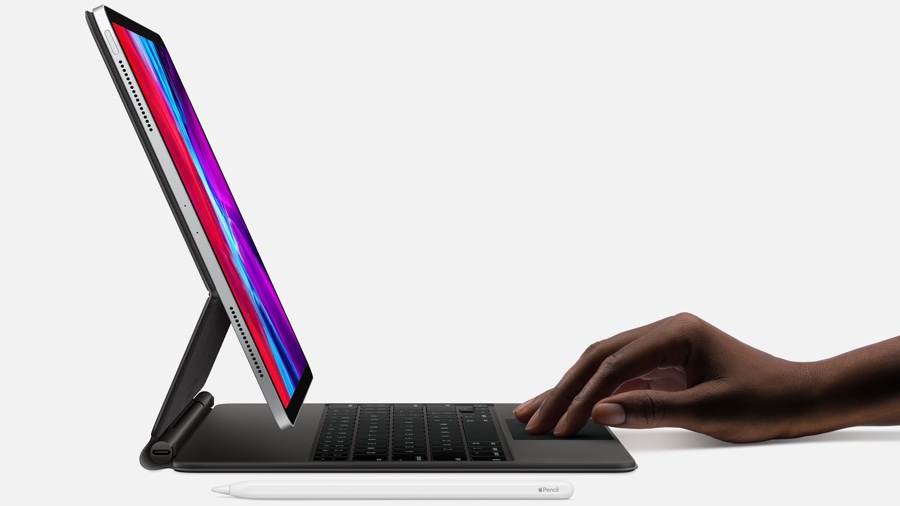
Both of these devices can be made more laptop-like with attachable keyboard covers and also offer optional styluses for illustration or handwriting input. Microsoft offers the Surface Pen and the Surface Go Signature Type Cover, and Apple has its second-generation Apple Pencil and the Apple Magic Keyboard with its unusual cantilever design.
The iPad Pro has a USB-C connector you can use to attach accessories and storage, and a magnetic connector for the Magic Keyboard. There's no headphone jack.
The Surface Pro 7 has a USB-C connector and a USB-A connector, a 3.5mm headphone jack, a Surface Connect port, a Surface Type Cover port and a microSDXC card reader. It’s also compatible with the Surface Dial, which is sold separately.
iPad Pro vs Surface Pro 7: Wireless
The iPad Pro has dual band 802.11ax Wi-Fi 6 HT80 with MIMO and Bluetooth 5.0. Wi-Fi + Cellular models have gigabit LTE.
The Surface Pro 7 also has 802.11ax Wi-Fi and Bluetooth 5.0, but unlike the Surface Go 2 there’s no LTE option here. For that you need the Surface Pro 7+ For Business, which is the new version of the Surface Pro X.
iPad Pro vs Surface Pro 7: Price and verdict
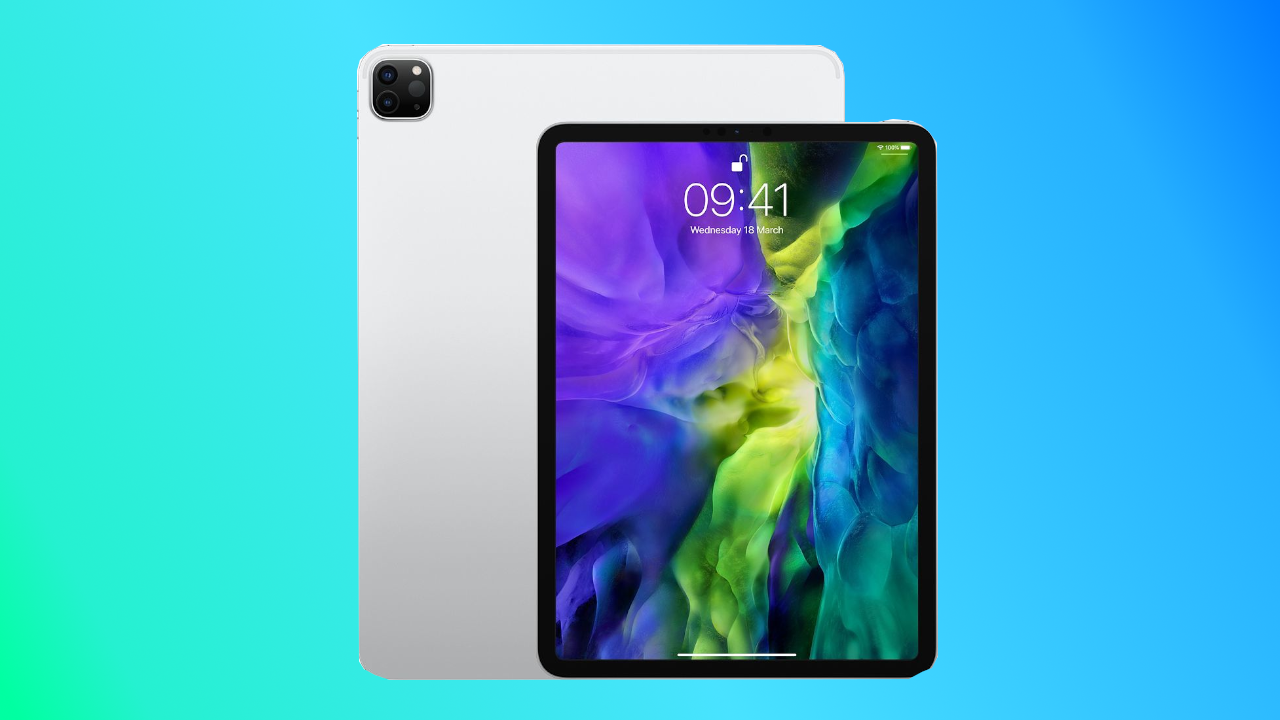
The 11-inch iPad Pro starts at £769 / $799 / AU$1,329 with 128GB of storage and can be ordered with up to 1TB for £1,269 / $1,299 / AU$2,179.
The 12.9-inch, 128GB model is £969 / $999 / AU$1,649, rising to £1,469 / $1,499 / AU$2,499 for the 1TB model. Wi-Fi + Cellular models cost £150 / $150 / AU$250 more than the Wi-Fi-only ones.
In some markets Microsoft is currently discounting some of the most affordable Surface models, such as the Core i3 / 4GB / 128GB, the Core i5 / 8GB / 128GB and the Core i5 8GB / 256GB. That means the cheapest Surface Pro 7 is £745 / $899 / AU$1,249. The most expensive model is the Core i7 / 16GB / 1TB, which comes in at £2,249 / $2,299 / AU$3,749.
So which is best? That depends very much on what you think a pro tablet should be. If you want it to deliver the same apps and experience as other tablets but with the best possible processor, performance and specification, or if you want your Pro tablet to include cellular connectivity, you should buy the iPad Pro (whether 2020 or 2021 model).
But if you want it to completely replace a Windows or Mac laptop, things are much less clear-cut. Your decision will ultimately come down to one thing: the availability and features of the apps you need to use. Either way, these two tablets are our picks as the best options.
Writer, musician and broadcaster Carrie Marshall has been covering technology since 1998 and is particularly interested in how tech can help us live our best lives. Her CV is a who’s who of magazines, newspapers, websites and radio programmes ranging from T3, Techradar and MacFormat to the BBC, Sunday Post and People’s Friend. Carrie has written more than a dozen books, ghost-wrote two more and co-wrote seven more books and a Radio 2 documentary series; her memoir, Carrie Kills A Man, was shortlisted for the British Book Awards. When she’s not scribbling, Carrie is the singer in Glaswegian rock band Unquiet Mind (unquietmindmusic).

